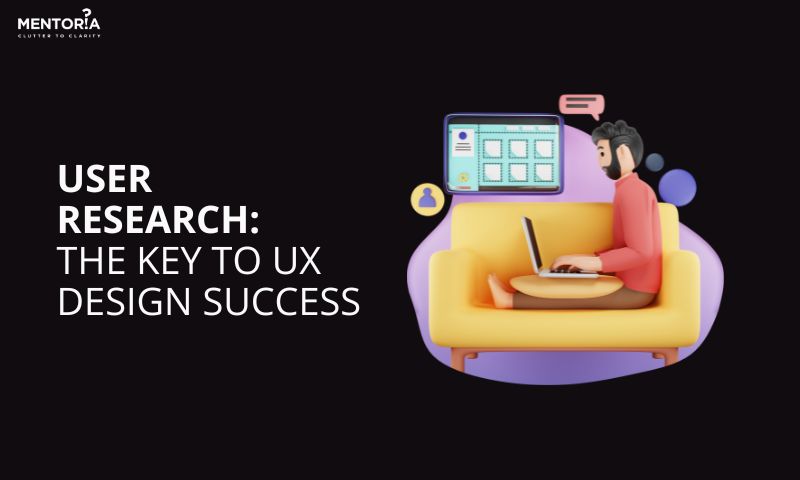User Research: The Key to UX Design Success

User research might sound like a fancy term, but it’s the down-to-earth practise of understanding your users, their needs, and their quirks. It’s like having a map that guides you through the maze of design decisions, helping you create digital experiences that people will love and cherish. User research is the key to unlocking the secrets of a users’ heart and mind. It’s how you understand what they need, want, and value, and how you can create products and services that truly meet their needs.
But user research isn’t just about understanding your users on a superficial level. It’s about getting deep into their motivations, their pain points, and their hopes and dreams. It’s about understanding what keeps them going, so you can design products and services that resonate with them on a deeper level. The first step to creating a user-centred UX design is to understand your users’ needs and goals. What are they trying to achieve when they use your product or service? What are their pain points? What are their frustrations? User research can help you answer these questions and gain a deep understanding of your users’ needs and goals. This understanding is essential for creating products and services that are truly useful and valuable to your users.
Once you understand your users’ needs and goals, you can start to focus on improving the usability of your product or service. User research can help you identify usability problems and make changes to improve the user experience. For example, user research can help you identify confusing labels, cluttered menus, and difficult-to-use features. It can also help you understand how users interact with your product or service, so you can design for ease of use. In this blog, we’re going to explore the importance of user research in UX design, and show you how it can help you elevate your ideas to amazing heights.
Understanding User Needs and Goals
You’re not designing for yourself; you’re creating something for your users. Think of Airbnb – they embarked on a journey of user research to cater to the unique needs of both hosts and guests. The result? Guest profiles, a nifty feature that lets hosts know more about their potential guests. This move was pure gold – it helped Airbnb create a win-win situation for both parties.
One of Airbnb’s game-changing innovations born out of user research is the introduction of guest profiles. Hosts often wanted to know more about potential guests to ensure a comfortable and secure stay. Airbnb recognised this need through user feedback and research findings. They realised that trust and transparency were essential to building a thriving community. In response, Airbnb introduced guest profiles, allowing users to share information about themselves and previous trips. Hosts could now get a better sense of who they were welcoming into their homes, fostering trust and enhancing the overall experience for both hosts and guests. This feature was a direct result of listening to their users, showcasing how user research can lead to the creation of user-centric solutions.
Improving Usability
No one likes a website or app that feels like a maze of confusion, which is why a usability interface is very important. Google Maps knows this all too well. They’re on a never-ending quest to make their maps user-friendly. Through user research, they’ve simplified their interface, added offline maps, and provided real-time traffic info. This ongoing effort makes sure you can always find that new coffee shop or navigate through traffic without pulling your hair out.
Google Maps continuously seeks feedback from its users. They have mechanisms in place to gather data on how users interact with the app. They pay attention to user reviews, conduct surveys, and take note of common issues and requests. This constant influx of feedback is invaluable in identifying areas for improvement. For instance, if users often express frustration about a particular aspect of the app’s interface or functionality, Google’s UX and product teams take action. They analyse the feedback, identify patterns, and prioritise updates based on the user pain points uncovered through research. This iterative process ensures that Google Maps evolves to meet users’ changing needs and expectations.
Identifying Pain Points
Amazon’s a giant, but they’re not immune to user woes. They used their massive resources to streamline the checkout process. Remember the time when Amazon’s checkout had more steps than a thriller novel? User research highlighted this pain point, and Amazon’s checkout became smoother than a buttered-up slide.
One of Amazon’s critical areas of focus is the checkout process. Amazon recognised that a lengthy or complicated checkout process could lead to cart abandonment, costing them sales and frustrating customers. User research played a pivotal role in identifying this issue. Through user feedback, Amazon realised that streamlining the checkout process was a top priority for users. As a result, Amazon introduced features like one-click ordering and secure payment options, such as Amazon Pay. These changes significantly reduced friction during the checkout process, improving the overall user experience and increasing conversion rates.
Amazon’s recommendation engine, often touted as one of the best in the business, is a direct result of user research. Amazon collects data on users’ browsing and purchasing behaviour, and user feedback to understand their preferences better.
Enhancing Accessibility
Apple has made significant strides in enhancing accessibility for users with disabilities. Through user research and feedback from individuals with diverse accessibility needs, Apple has improved features like VoiceOver (a screen reader), Switch Control, and Magnifier, making their products more inclusive and user-friendly.
Apple is renowned for its commitment to accessibility. A significant portion of this dedication is driven by user research and feedback. The introduction of VoiceOver, Apple’s screen reader for people with visual impairments, is a standout example. VoiceOver allows users to navigate and interact with Apple’s devices without needing to see the screen. This feature was a direct result of user research, conducted in collaboration with blind and visually impaired users, to understand their unique needs and challenges. Apple’s accessibility features extend beyond VoiceOver and include features like Switch Control for motor-impaired users and Magnifier for those with low vision. These innovations are continually refined based on user research and feedback, making Apple’s products more inclusive and user-friendly.
Optimising Content and Information Architecture
The New York Times has conducted extensive user research to improve its digital content presentation. By understanding how readers engage with their content, they’ve optimised their website’s information architecture, resulting in a more user-friendly and engaging online experience.
The New York Times recognises the importance of delivering its extensive content in an easily navigable and engaging manner. Through user research, they understand how readers consume content and what types of layouts and structures are most user-friendly. User research helps the NYT optimise its website’s information architecture, ensuring that readers can easily find and access articles on various topics. This might involve rearranging sections, creating intuitive navigation menus, and prioritising content based on readers’ preferences and behaviour.
Subsequently the importance of user research in UX design cannot be underscored. It acts as a guidepost for the creation of products and services, ensuring that they fulfil the needs and expectations of their intended consumers. We’ve seen how industry titans like Airbnb, Google Maps, Amazon, Apple, and The New York Times employ user research to provide exceptional user experiences through real-world case studies.
These companies have elevated user experiences and set high standards for their respective industries, from the introduction of guest profiles on Airbnb to Google Maps’ real-time traffic information, Amazon’s streamlined checkout process, Apple’s accessibility features, and The New York Times’ optimised content presentation.
Enhancing Experiences With Mentoria
User research helps designers to understand what users want, need, and struggle with. This information can then be used to design products and services that are more user-friendly and effective. Mentoria can help in upskilling the younger generation who are looking out for a career, as well as experienced professionals who are looking to upgrade themselves. Innovative ideas can be implemented through natural confidence acquired by learning and enhancing skills. We also equip them with knowledge and experience for them to be able to tackle their dream career.









